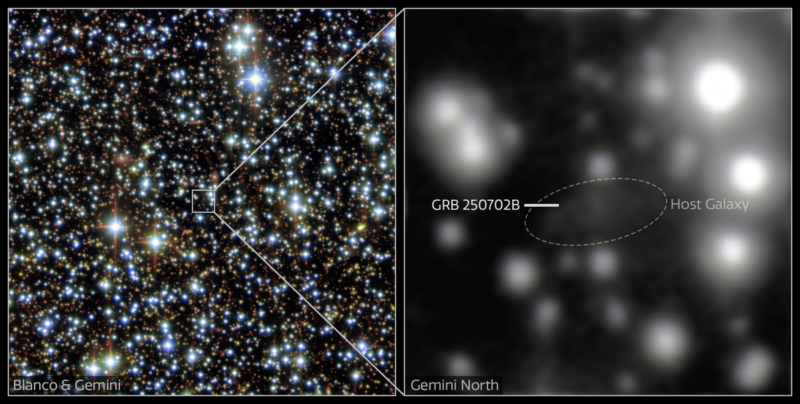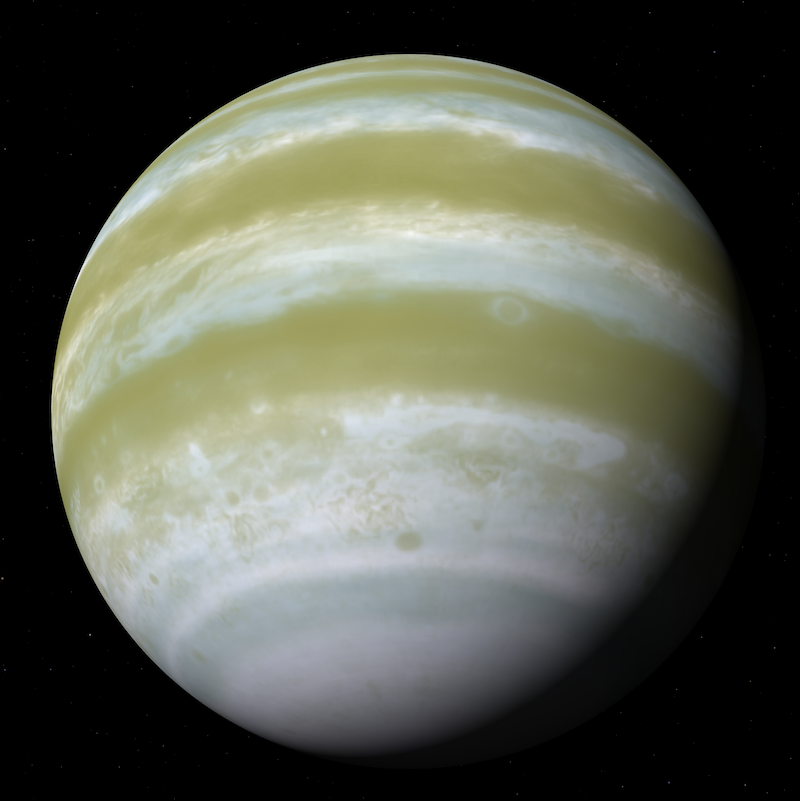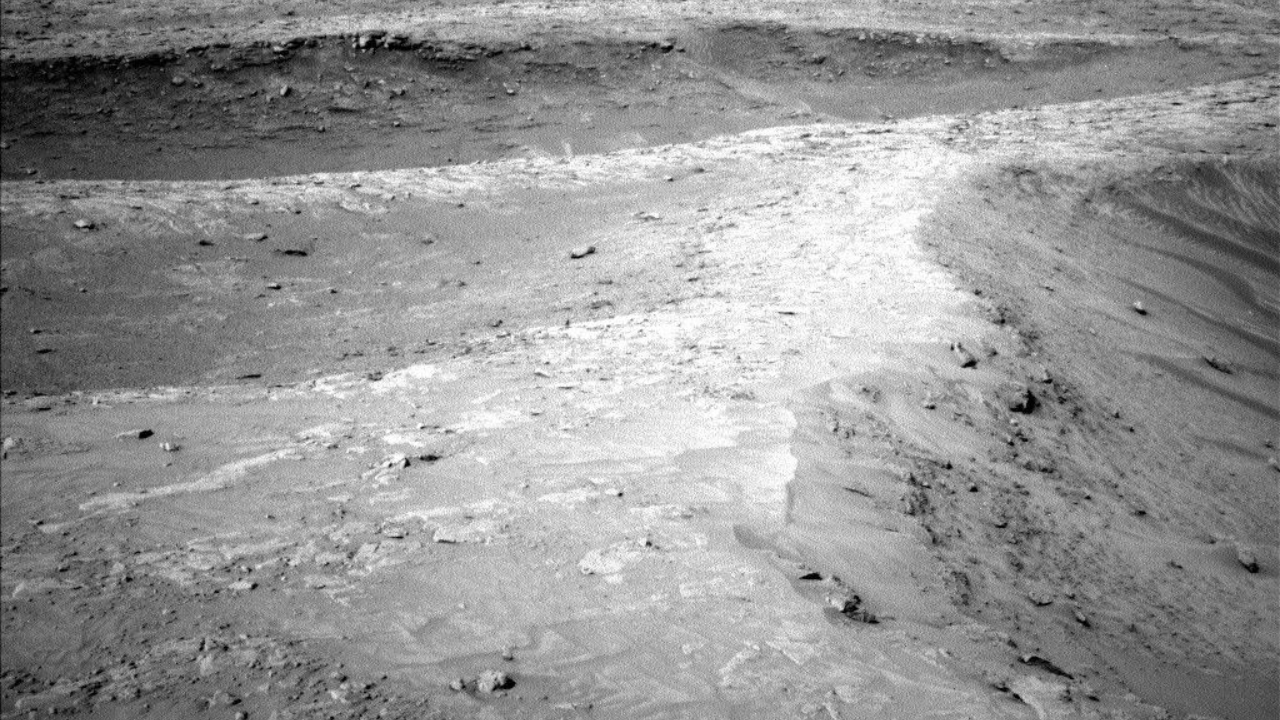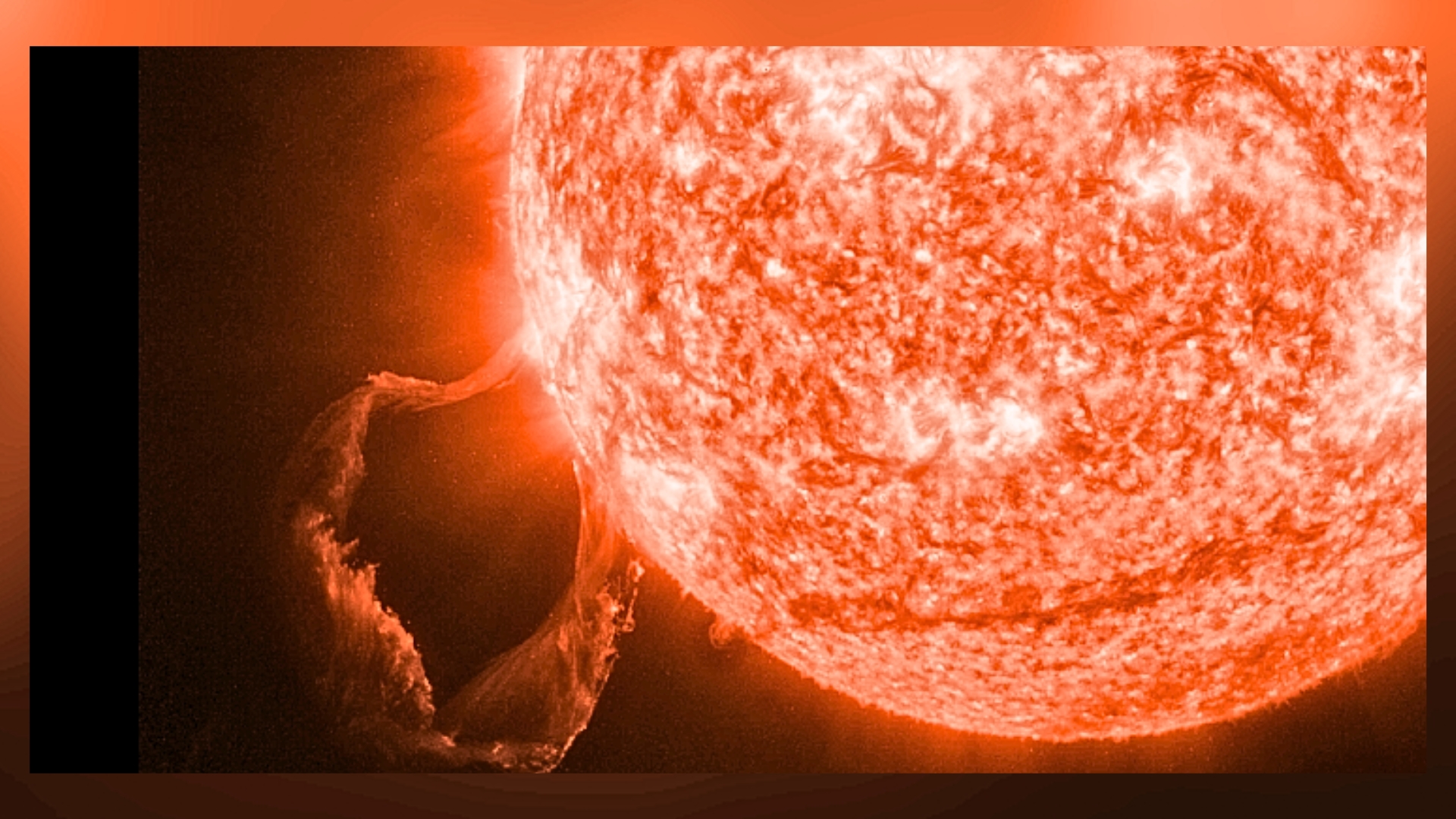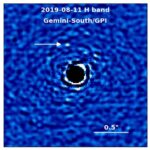Now Reading: New moon discovered orbiting inside distant Uranus’ rings
-
01
New moon discovered orbiting inside distant Uranus’ rings
New moon discovered orbiting inside distant Uranus’ rings
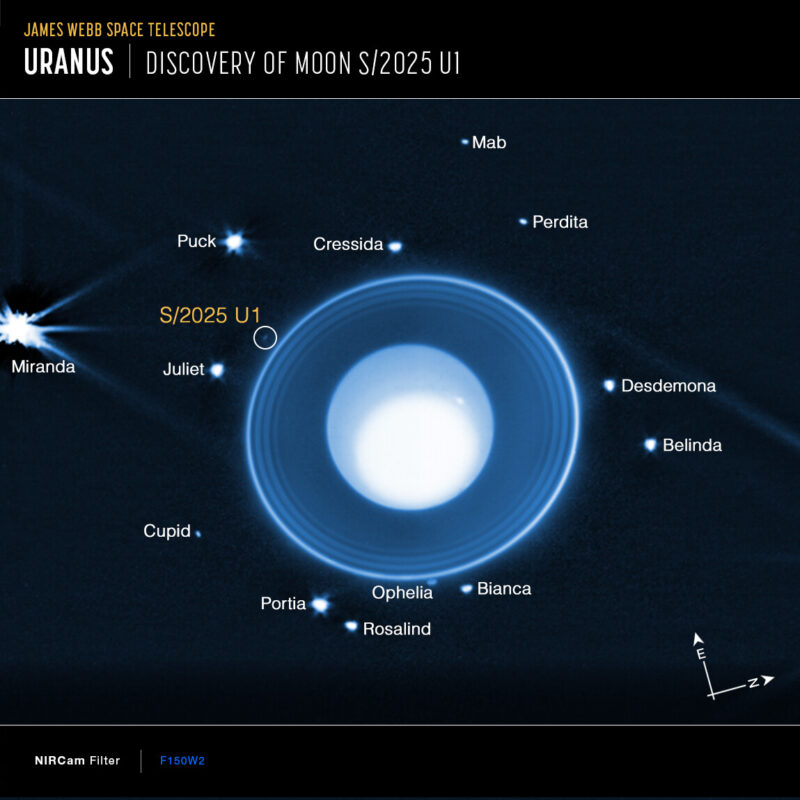
This story was originally published by the NASA Webb Mission Team. Edits by EarthSky.
Editor’s note: This post highlights data from Webb science in progress, which has not yet been through the peer-review process.
- A new tiny moon orbiting Uranus was identified in February 2025 using the James Webb Space Telescope’s Near-Infrared Camera. The team captured a series of ten 40-minute exposures to detect it.
- Extremely small and faint, the moon measures only about 6 miles (~10 km) across. It is too dim for Voyager 2 or the Hubble Space Telescope to detect.
- This brings Uranus’s known moons to 29, expands understanding of its inner moon system and hints that even more such small satellites may await discovery.
Voyager 2, Hubble missed this tiny new moon
Using NASA’s James Webb Space Telescope, a team led by the Southwest Research Institute has identified a previously unknown moon orbiting Uranus. This expands the planet’s known satellite family to 29. The detection was made during a Webb observation on February 2, 2025.
Maryame El Moutamid, a lead scientist at the Southwest Research Institute and principal investigator on Webb observing program 6379 to study the rings and moons of Uranus, described the discovery:
This object was spotted in a series of 10 40-minute long-exposure images captured by the Near-Infrared Camera. It’s a small moon but a significant discovery, which is something that even NASA’s Voyager 2 spacecraft didn’t see during its flyby nearly 40 years ago.
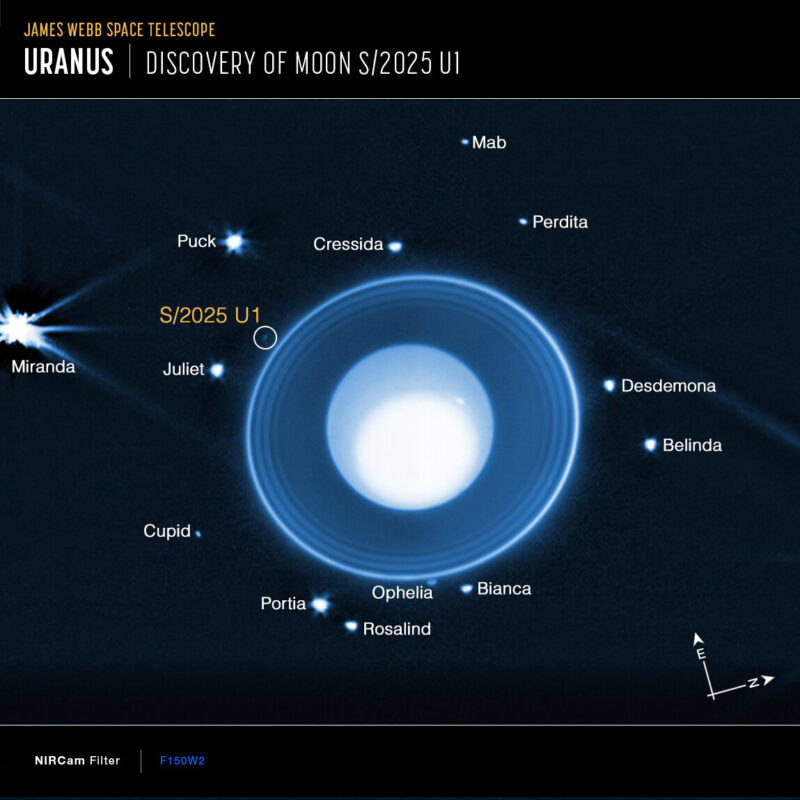
New moon currently named S/2025 U1
The time-lapse animation (embedded above) shows the newly discovered moon of Uranus, designated S/2025 U1. It also shows 13 of the 28 other known moons orbiting the planet. The observations by NASA’s James Webb Space Telescope’s Near-Infrared Camera were taken over the course of about six hours on February 2, 2025, under program ID 6379. The animation is comprised of data taken with the Near Infrared Camera’s wide band F150W2 filter, which transmits infrared wavelengths from about 1.0 to 2.4 microns. Also, due to the drastic differences in brightness levels, the animation is a composite of three different treatments of the data. This allows the viewer to see details in the planetary atmosphere, the surrounding rings and the orbiting moons.
The newly discovered moon is estimated to be just 6 miles (10 kilometers) in diameter. This assumes it has a similar reflectivity (albedo) to Uranus’ other small satellites. In fact, that tiny size likely rendered it invisible to Voyager 2, a NASA probe launched in 1977, and other telescopes.
Matthew Tiscareno of the SETI Institute and a member of the research team described the discovery’s significance:
No other planet has as many small inner moons as Uranus, and their complex interrelationships with the rings hint at a chaotic history that blurs the boundary between a ring system and a system of moons. Moreover, the new moon is smaller and much fainter than the smallest of the previously known inner moons, making it likely that even more complexity remains to be discovered.
New moon orbits at the edge of Uranus’ main ring system
The image released by the research team is a complex one. At center is the planet Uranus, a blue globe with a large white spot occupying most of the planet. It’s surrounded by a series of rings that get brighter as you move outward. Then, beyond the rings are 14 labeled moons appearing as points of light. Finally, just at the edge of the outermost visible ring at 10 o’clock, a faint moon is circled and labeled S 2025 U1.
At far left, the brightest moon is labeled Miranda. In addition, other moons clockwise from Miranda are Puck, Cressida, Mab, Perdita, Desdemona, Belinda, Bianca, Ophelia, Rosalind, Portia, Cupid and Juliet.
The moon Cordelia, discovered by Voyager 2 in 1986, orbits just inside the outermost ring, but is not visible in these views due to glare from the rings. Because of those drastic differences in brightness levels, the image is a composite of three different treatments of the data, allowing the viewer to see details in the planetary atmosphere, the surrounding rings and the orbiting moons. The data was taken with the Near-Infrared Camera’s wide band F150W2 filter, which transmits infrared wavelengths from about 1.0 to 2.4 microns.
Tiny moon has a nearly circular orbit
The new moon is the 14th member of the intricate system of small moons orbiting inward of the largest moons Miranda, Ariel, Umbriel, Titania and Oberon.
All the moons of Uranus are named after characters in works of the English writers William Shakespeare and Alexander Pope.
El Moutamid described how it fits into the system:
It’s located about 35,000 miles (56,300 kilometers) from Uranus’ center, orbiting the planet’s equatorial plane between the orbits of Ophelia – which is just outside of Uranus’ main ring system – and Bianca. Its nearly circular orbit suggests it may have formed near its current location.
A name for the newly found moon will need to be approved by the International Astronomical Union, the leading authority in assigning official names and designations to astronomical objects.
Discovery continues ancient tradition of human exploration
El Moutamid said the Webb telescope played a critical role in discovering the new moon:
Through this and other programs, Webb is providing a new eye on the outer solar system. This discovery comes as part of Webb’s General Observer program, which allows scientists worldwide to propose investigations using the telescope’s cutting-edge instruments. The NIRCam instrument’s high resolution and infrared sensitivity make it especially adept at detecting faint, distant objects that were beyond the reach of previous observatories.
She also said finding the new moon at Uranus continues the history of humanity’s ongoing exploration of our solar system:
Looking forward, the discovery of this moon underscores how modern astronomy continues to build upon the legacy of missions like Voyager 2, which flew past Uranus on January 24, 1986, and gave humanity its first close-up look at this mysterious world. Now, nearly four decades later, the James Webb Space Telescope is pushing that frontier even farther.
Bottom line: Astronomers have discovered a 29th moon orbiting Uranus. The newly found moon is 6 miles (10 kilometers) wide.
Read more: Oceans for 4 Uranus moons likely, astronomers say
The post New moon discovered orbiting inside distant Uranus’ rings first appeared on EarthSky.
Stay Informed With the Latest & Most Important News
Previous Post
Next Post
-
 012024 in Review: Highlights from NASA in Silicon Valley
012024 in Review: Highlights from NASA in Silicon Valley -
 02Panasonic Leica Summilux DG 15mm f/1.7 ASPH review
02Panasonic Leica Summilux DG 15mm f/1.7 ASPH review -
 03From Polymerization-Enabled Folding and Assembly to Chemical Evolution: Key Processes for Emergence of Functional Polymers in the Origin of Life
03From Polymerization-Enabled Folding and Assembly to Chemical Evolution: Key Processes for Emergence of Functional Polymers in the Origin of Life -
 04How New NASA, India Earth Satellite NISAR Will See Earth
04How New NASA, India Earth Satellite NISAR Will See Earth -
 05And Thus Begins A New Year For Life On Earth
05And Thus Begins A New Year For Life On Earth -
 06Astronomy Activation Ambassadors: A New Era
06Astronomy Activation Ambassadors: A New Era -
07SpaceX launch surge helps set new global launch record in 2024













